Dehydrating food is a useful skill that can have various benefits, such as extending the shelf life of seasonal produce and creating your own emergency food supply. Today, we’ll be dehydrating shrimp, and we’ll provide you with a step-by-step guide to successfully dehydrate and preserve these tiny yet flavorful crustaceans
We’ll be using previously frozen precooked salad shrimp for our dehydration project. These small-size shrimp are not only quick to dehydrate, but they also pack a punch of flavor and nutrition. Whether you’re looking to stock up on dried ingredients or create delicious rehydratable meals for your camping adventures, dehydrated shrimp can be a versatile addition to your culinary arsenal.
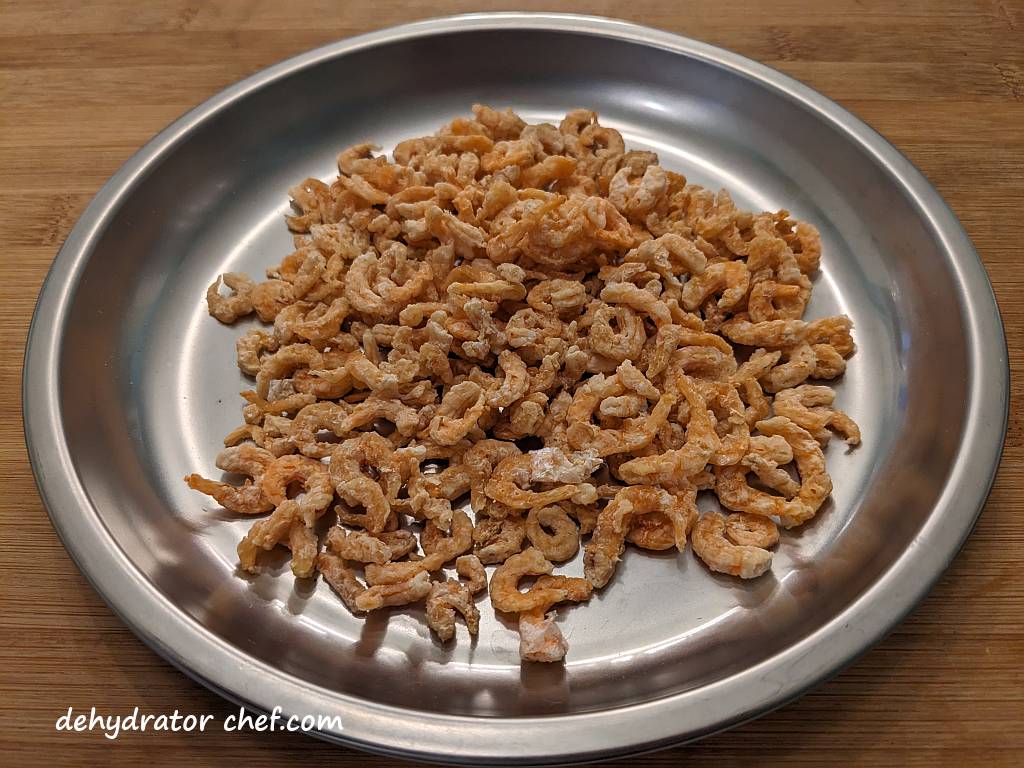
So, grab your dehydrator, and let’s get started!
Table of Contents
- How to Dehydrate Shrimp
- Supplies Needed for Dehydrating Shrimp
- Step 1. Process the Frozen Shrimp for Dehydrating
- Step 2. Preparing the Dehydrator for Dehydrating Shrimp
- Step 3. Dehydrating Shrimp
- Step 4. When are the Dehydrated Shrimp Done
- Step 5. Equalizing and Conditioning of the Dehydrated Shrimp
- Step 6. Storing Dehydrated Shrimp
- How to Rehydrate Dried Shrimp
- Weights, Measures, and Serving Sizes
- Insider Tips
How to Dehydrate Shrimp
With the Dehydrator Chef approach, we want our dehydrated meals to reconstitute fairly quickly when we are prepping our food using a camp stove.

You need a good quality food dehydrator to dehydrate shrimp. We use the Nesco FD-75A, and you can check out our food dehydrator guide here and why we think Nesco offers the best bang for the buck. We believe this is the best food dehydrator for our long-term food storage needs. Nesco has other models of food dehydrators and accessories, check them all out here.
You’ll also need the removable mesh screen inserts; one will be needed for each of the dehydrator trays.
For planning purposes, a 16-ounce package of these tiny shrimp will fill 2 Nesco FD-75A dehydrator trays lined with the removable mesh screen inserts.
Supplies Needed for Dehydrating Shrimp
- Bagged frozen salad shrimp
- Common kitchen tools such as cutting boards, chef’s knife, colander, etc.
- Food dehydrator, with removable mesh screen inserts, one for each dehydrator tray
- Clear canning jars with tight-fitting lids
- Wide-mouth canning jar funnel
- Food-safe desiccant packets
Step 1. Process the Frozen Shrimp for Dehydrating
We begin by opening the bag and rinsing the shrimp in batches under cold water for about a minute. Then, we drain the excess water from the shrimp in a colander.
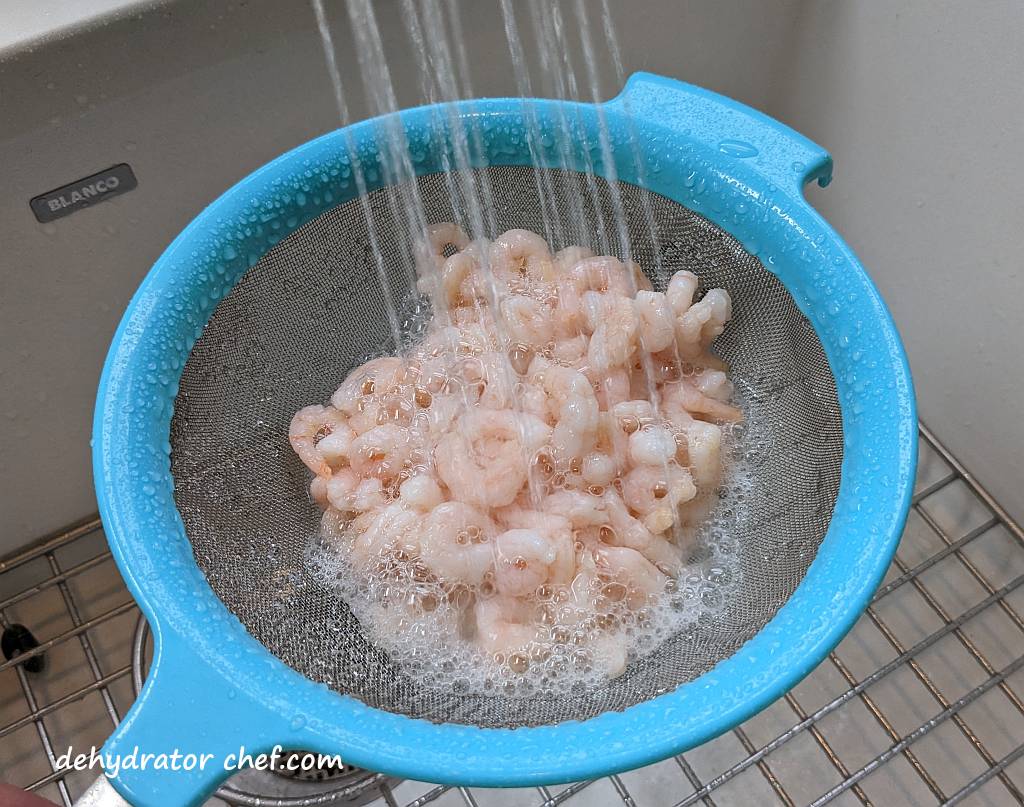
That’s it. Easy enough.
Step 2. Preparing the Dehydrator for Dehydrating Shrimp
To dry the shrimp, spread them out on the mesh screen inserts in a single layer. This will help them dry faster. As you spread them out, remove any shell bits or other unwanted material.
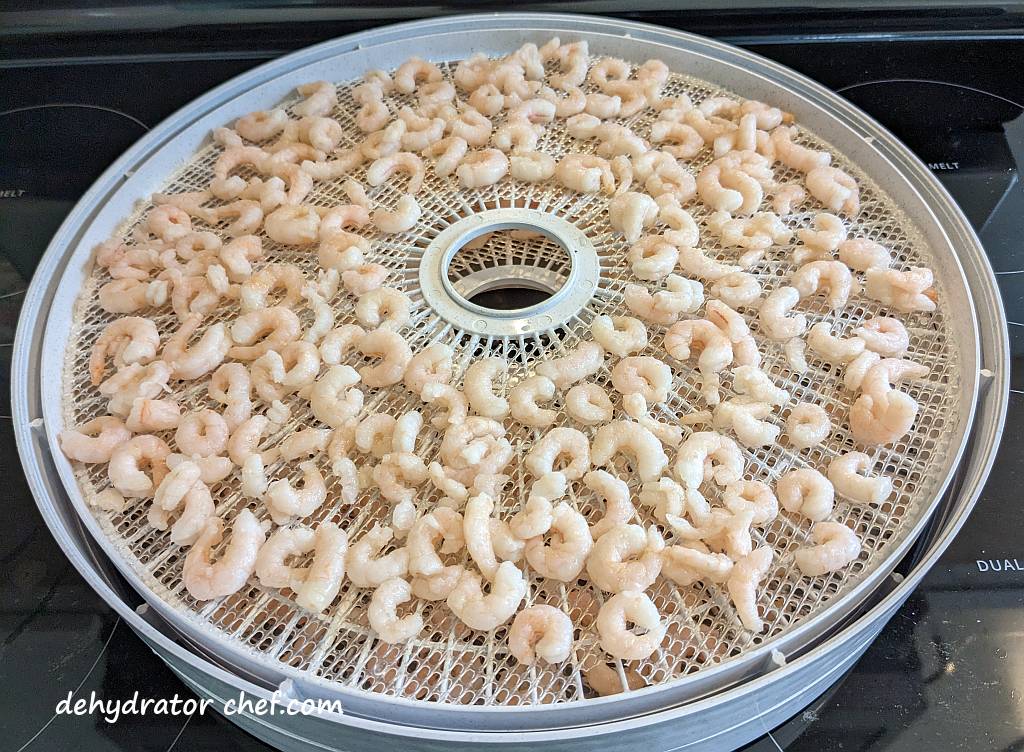
Nesco Clean-A-Screens are mesh screens that are flexible and removable. They have a top and bottom side, with each side being distinct. If you were to look at the mesh screens under a high-powered microscope, you would notice that the individual strands of the mesh have a triangular shape. The bottom side feels smooth, while the top side has the point of the triangle and feels rough when you rub your fingers across it.
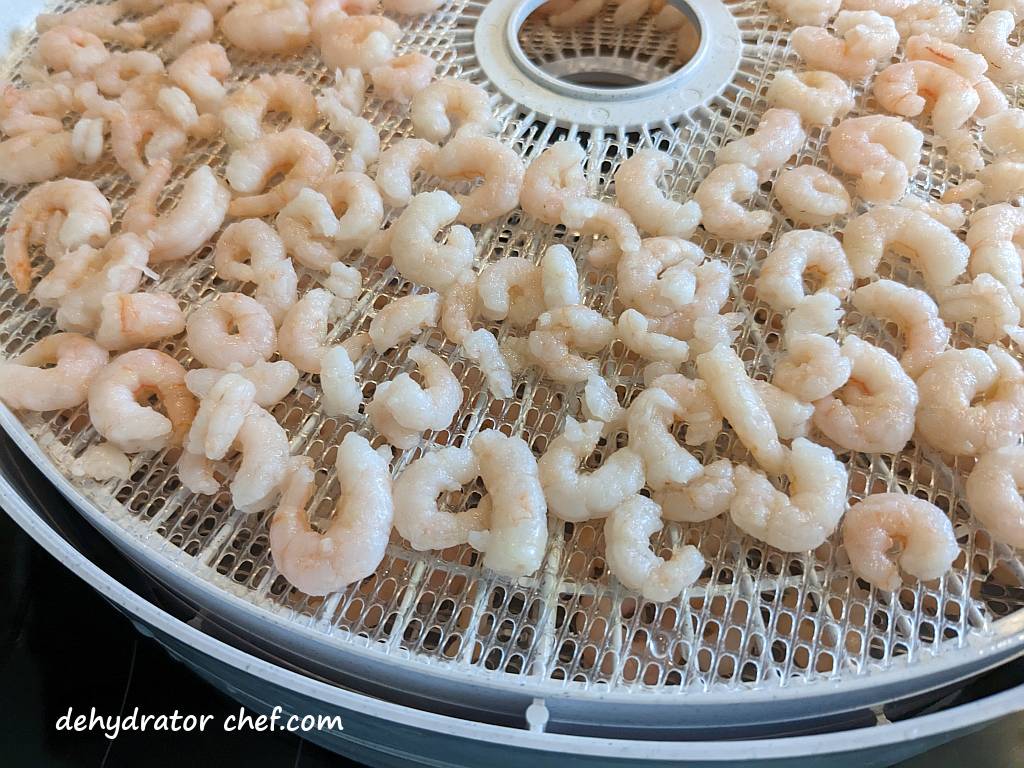
For optimal results, ensure that you leave some space between the shrimp pieces on the dehydrator trays to allow for proper airflow and drying. The Nesco 13.5-inch round dehydrator tray has close to 119 square inches or .8 square feet of surface area for drying.
Step 3. Dehydrating Shrimp
Set the dehydrator thermostat temperature to 160 °F / 71 °C to dehydrate the tiny shrimp. I find that 10 to 12 hours is about the right amount of time.

Dehydrating shrimp does produce a strong fish smell. So you might want to dry shrimp in the garage or outdoors; otherwise, open the windows and get a fan going.
Drying times depend on your food dehydrator, the ambient temperature and humidity, the number of dehydrator trays, the size of food items, and how crowded you fill your dehydrator trays. Refer to your dehydrator owner’s manual for recommended temperatures and times for dehydrating specific foods. Remember to use drying times as a guide.
Step 4. When are the Dehydrated Shrimp Done
After 10 to 12 hours, the shrimp should be fully dehydrated. If not, let it go another 2 or 4 hours and check again.

Warm shrimp still in the food dehydrator will feel somewhat pliable, and you may believe it needs more drying time. Simply unplug the dehydrator and let everything cool down. Then check again to be sure. The dehydrated shrimps are brittle and should be hard little nuggets when done.
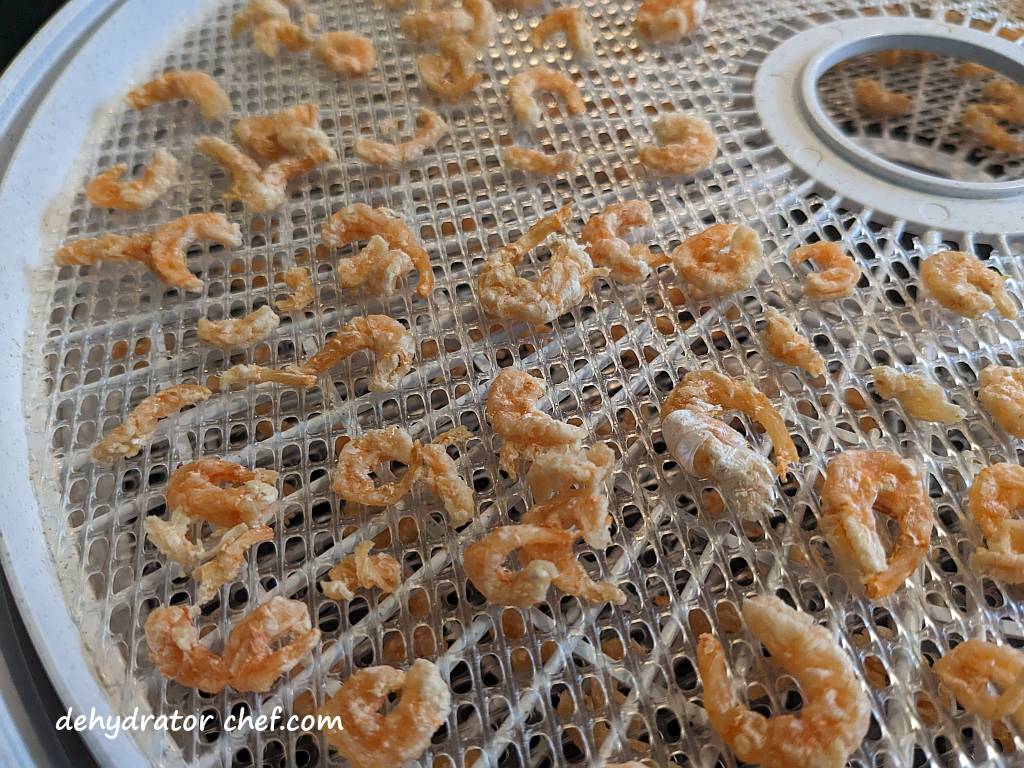
Step 5. Equalizing and Conditioning of the Dehydrated Shrimp
When the dehydrated shrimps are removed from the dehydrator, the remaining moisture may not be distributed equally among all of the pieces because of their location and position in the dehydrator. Equalizing and conditioning is a process for freshly dehydrated foods that ensures any residual moisture remaining in any piece is spread, or equalized, among all the other pieces in the batch. Let the dried shrimps equalize and condition in the storage container for 7 to 10 days.
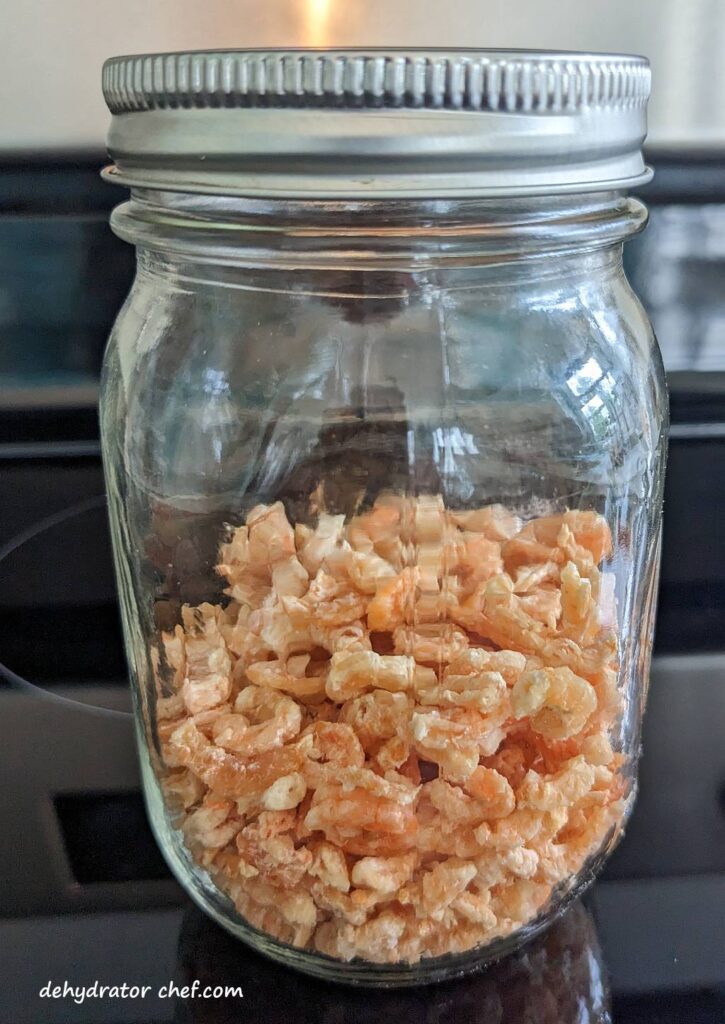
We always recommend letting food items cool completely after they have finished dehydrating and before packing them into an airtight storage container for equalizing and conditioning. Warm food may cause sweating which could provide just enough moisture for mold to grow.
After a short cooling period, pack the dehydrated shrimp into clean, dry, insect-proof containers with tight-fitting lids. We’ll use pint- and quart-size canning jars for this task. Fill the jars at most 2/3 to 3/4 full, leaving some headspace.
Headspace is the distance between the food surface and the lid’s underside. Its purpose is to provide ample space for the dehydrated food product to slide and tumble when shaken and rotated to expose any evidence of clumping or sticking.
Dehydrated food items do not take long to start hydrating from naturally occurring household humidity. Do not leave dehydrated food items exposed to the elements any longer than necessary because of the increased risk of mold growth.
A quality stainless steel or plastic canning funnel makes the messy job of getting dehydrated foods off the dehydrator tray removable inserts and into the canning jars an easy task. Take a minute or two and check them out here on Amazon.
Every day, check the jar for moisture. Roll the jar contents around and note any clumping or sticking. If seen, put the contents back on the dehydrator for several more hours. Since canning jars are clear, it’s easy to see what’s inside.
Lastly, if you notice any mold at all, even the smallest bit, throw it all out. What you see are the mold spores finally blooming enough to make them visible. But there are more, even tinier mold spores in the rest of your jar that make your dehydrated food inedible. Toss it out, clean your gear, and start another batch..
Step 6. Storing Dehydrated Shrimp
In the equalizing and conditioning phase in Step 5, we left some headspace so we could easily inspect the dehydrated shrimp. Now we are in the storage phase, we can now pack the dried shrimp into clean, dry, insect-proof containers as tightly as possible without crushing.
We’ll now add a food-safe desiccant packet for moisture control because we live in a fairly humid area. For our pint-size or quart-size mason jars, we’ll use a single food-safe 5-gram desiccant packet. The desiccant packets will absorb any moisture and extend the shelf life of the dehydrated shrimp.

I don’t use a desiccant packet for moisture control during the equalizing and conditioning phase in Step 5. Doing so might mask moisture issues should the food items not be adequately dried.

We use these inexpensive food-safe desiccant packets, which are available from Amazon. These 5-gram packets have over 5000 of mostly 4- and 5-star customer reviews, with an average of 4.7 stars out of 5. Our bag of 60 desiccant packets will last quite a while because they can be recharged and reused multiple times. Other food-safe sizes are available.
The dehydrated shrimp might keep up to 4 or 5 months. Exactly how long depends on preparation, how well the shrimp was dehydrated, pantry storage conditions, and storage containers. Optionally, vacuum seal and freeze them for up to a year.
Lastly, attach or include a short note describing the contents and the date the product was dehydrated. The note also informs us where to go in the dehydrator logbook to make another note.
How to Rehydrate Dried Shrimp
To rehydrate dried shrimp, use enough water to completely submerge and soak them for at least 5 minutes in a covered pot. Periodically check to make sure they stay covered with water.
Dried shrimp reconstitutes faster using boiled water, so bring the mix to a boil, then turn down the heat to a simmer for 1 to 2 minutes, stirring occasionally. Continue checking the water level and make sure the shrimps remain submerged. Then remove from the heat.
Leave the cover on the cooking pot and let the mix continue to hydrate for another 15 to 20 minutes. Consider wrapping the cooking pot in a cozy to retain heat. Once fully hydrated, drain any excess water.
The rehydrated shrimp won’t look identical to what we started with, they will look somewhat shriveled and that is to be expected. However, it will have a similar texture and taste to fresh from the bag shrimp we started with.
Weights, Measures, and Serving Sizes
If you’re using these dehydrated shrimp as part of a Dehydrator Chef recipe, just follow the recipe instructions.
This information is a representative summary of the notes we keep in a logbook on most of our food dehydration efforts.
- We started with a 16-ounce bag of shrimp, 250-300 shrimp per pound
- Relevant Nutrition Facts:
- Servings about 5
- Serving size: 3 ounces (85 grams)
- 454 grams / 5 servings = 91 grams
Product details
- We started with a 16-ounce / 454-gram bag of salad shrimp, 250-300 shrimp per pound
- Relevant Nutrition Facts:
- Servings about 5
- Serving size: 3 ounces (85 grams)
- 454 grams / 5 servings = 91 grams
Independent measurement details
- The rinsed and drained weight: 457 grams
- 1/2 cup measured amount of salad shrimp weighed 75 grams
- 457 grams / 5 servings = 91 grams
Dehydration details
- Working in batches, rinsed under cold water, then drained in a colander
- Next, layer the shrimp onto the mesh inserts on the dehydrator trays, removing any shell pieces as they are found. Used 2 trays and mesh screens
- Started by setting the dehydrator temperature to 160 °F / 71 °C. Trays on the dehydrator at 0700.
- Checked at 1900, it’s been 12 hours, they are done
- The entire batch of dried shrimp was 77 grams by weight.
- 77 grams / 5 servings = 15.4 grams per serving of dehydrated shrimp. Rounding to a serving size of 15 grams.
Insider Tips
Store your dehydrated shrimp in a cool, dry, and dark place to prevent them from losing their flavor and color. You can also vacuum seal and freeze them for long-term storage, 4 or 5 months to a year.
